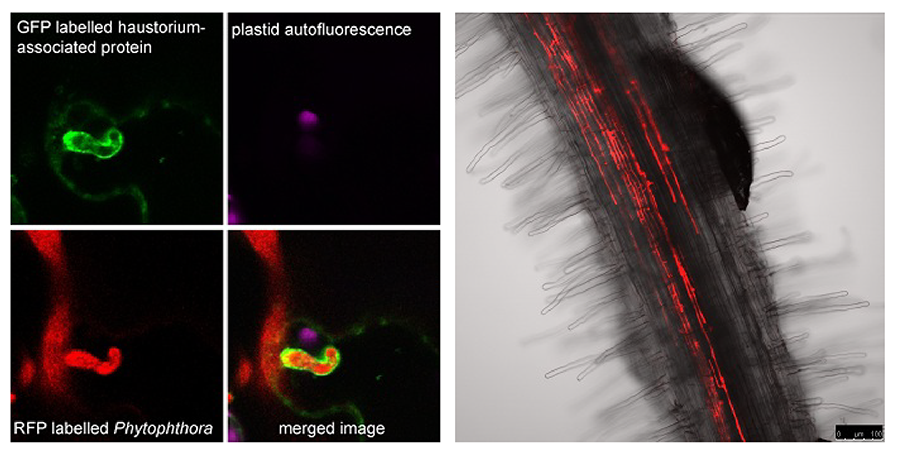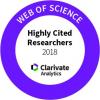Research Interests
My research revolves around microbe-induced host cell reprogramming by effector proteins that are shuttled into plant cells. Effectors are a hallmark for animal and plant pathogens’ success in conquering the host. Plant populations frequently maintain counter-defensive disease resistance proteins (R proteins) for intracellular recognition of effectors. Studying R protein mechanisms thus reveals plant strategies in coping with constant pathogen challenge.
During my masters and Ph.D. studies with Thomas Lahaye in Halle I characterised the tomato TIR-NB-LRR protein Bs4. Bs4 confers resistance towards the bacterial pathogen Xanthomonas campestris pv vesicatoria [1]. Xanthomonads are the causal agents of economically important bacterial plant diseases in tomato, pepper, citrus and rice. Tomato Bs4-mediated resistance is achieved by cytoplasmic recognition of a set of Xanthomonas-translocated transcription activator-like (TAL) effector proteins [2].
TAL effectors have a striking structure with central repeats and transcription activation domain and localise to host cell nuclei. They basically represent transcription factors that induce a set of host genes which in turn affect host physiology and development to support Xanthomonas infection. During a short postdoc following my Ph.D. in the same lab, I studied the TAL effector AvrHah1 [3].
I was intrigued by how these TAL effectors find their specific target gene promoters. The similarity of AvrHah1 to existing effectors together with other data obtained in the labs of Prof. Ulla Bonas and Prof. Thomas Lahaye enabled my colleague Jens Boch and me to break a fundamental code of DNA-binding specificity [4,5]. This discovery led to generation of customised TAL activators and nucleases with unrivalled DNA binding specificity that are now frequently being exploited in biomedicine as illustrated by a flurry of publications. I am trying to keep up with these in my blog: www.scoop.it/t/tal-effector-science.
My next stop was the group of Sophien Kamoun at the Sainsbury Laboratory in Norwich, where I studied the interactions of plants and oomycetes. I primarily use cell biology approaches to study Phytophthora infestans, the Irish potato famine pathogen in Nicotiana benthamiana [6]. I contributed to understanding of trafficking and function of the phylogenetically ancient class of Crinkler effectors. It was surprising to find that despite their diversity they all target the host nucleus [7]. I then continued my interest in studying P. infestans effectors that contribute to the development and maintenance of dedicated accommodation structures formed between microorganism and plant cell, called haustoria [8].
Left images: A GFP-labelled protein functions at Phytophthora haustoria structures. Right image: Red fluorescent Phytophthora colonising a Medicago truncatula (barrel medic) root.
References:
[1] Schornack et al. (2004) Plant J, 37, 46-60.
[2] Schornack et al. (2005) Mol Plant Microbe Interact, 18, 1215-1225.
[3] Schornack et al. (2008) New Phytol, 179, 546-556.
[4] Boch and Schornack (2010) IS-MPMI Reporter, 1, 3-4.
[5] Boch, Scholze, Schornack et al. (2009) Science, 326, 1509-1512.
[6] Chaparro-Garcia et al. (2011) PLoS One, 6, e16608.
[7] Schornack et al. (2010) Proc Natl Acad Sci U S A, 107, 17421-17426.
[8] Bozkurt, Schornack et al. (2011) Proc Natl Acad Sci U S A, 108
Key Publications
Carella, P., Gogleva, A., Tomaselli, M., Alfs, C., and Schornack, S. (2018) Phytophthora palmivora establishes tissue-specific intracellular infection structures in the earliest divergent land plant lineage. PNAS (Online Early: https://doi.org/10.1073/pnas.1717900115) Previously on bioRxiv (2017, Pre-Print). doi: https://doi.org/10.1101/188912. Watch YouTube video
Rey T., Chatterjee A.,Buttay M., Toulotte J., Schornack S. (2014) Medicago truncatula symbiosis mutants affected in the interaction with a biotrophic root pathogen. New Phytol. http://onlinelibrary.wiley.com/doi/10.1111/nph.13233/full
Wang E., Schornack S., Marsh J.F., Gobbato E., Schwessinger B., Eastmond P., Schultze M., Kamoun S., Oldroyd G.E. (2012) A Common Signaling Process that Promotes Mycorrhizal and Oomycete Colonization of Plants. Curr Biol. 22(23)
Bozkurt, T.O.*, Schornack, S.*, Win, J., Shindo, T., Oliva, R., Cano, L.M., Jones, A.M.E., Huitema, E., van der Hoorn, R.A.L., Kamoun, S. (2011) Phytophthora infestans effector AVRblb2 prevents focal secretion of a plant immune protease, Proc Natl Acad Sci USA 108(51), * shared first authors
Chaparro-Garcia A., Wilkinson R.C., Gimenez-Ibanez S., Findlay K., Coffey M.D., Zipfel C., Rathjen J.P., Kamoun S.*, Schornack S.* (2011) The Receptor-Like Kinase SERK3/BAK1 Is Required for Basal Resistance against the Late Blight Pathogen Phytophthora infestans in Nicotiana benthamiana. PLoS ONE 6(1). * shared corresponding authors
Schornack S.*, van Damme M.*, Bozkurt T.O., Cano L.M., Smoker M., Thines M., Gaulin E., Kamoun S., Huitema E. (2010): Ancient class of translocated oomycete effectors targets the host nucleus. Proc Natl Acad Sci USA 107(40). * shared corresponding authors
Selected reviews
Carella, P., and Schornack, S. (2017) Manipulation of bryophyte hosts by pathogenic and symbiotic microbes. Plant and Cell Physiology, pcx182, https://doi.org/10.1093/pcp/pcx182
Rey T., Schornack S. (2013): Interactions of beneficial and detrimental root-colonizing filamentous microbes with plant hosts. Genome Biol. 14(6). Review.
Schornack S., Moscou M.J., Ward E.R., Horvath D.M. (2013): Engineering Plant Disease Resistance Based on TAL Effectors. Annu Rev Phytopathol. 51. Review.
Bozkurt T.O., Schornack S., Banfield M.J., Kamoun S. (2012): Oomycetes, effectors, and all that jazz. Curr Opin Plant Biol. [epub]
Schornack S., Huitema E., Cano L.M., Bozkurt T.O., Oliva R., Van Damme M., Schwizer S., Raffaele S., Chaparro-Garcia A., Farrer R., Segretin M.E., Bos J., Haas B.J., Zody M.C., Nusbaum C., Win J., Thines M., Kamoun S. (2009): Ten things to know about oomycete effectors. Mol Plant Pathol. 10(6). Review.



